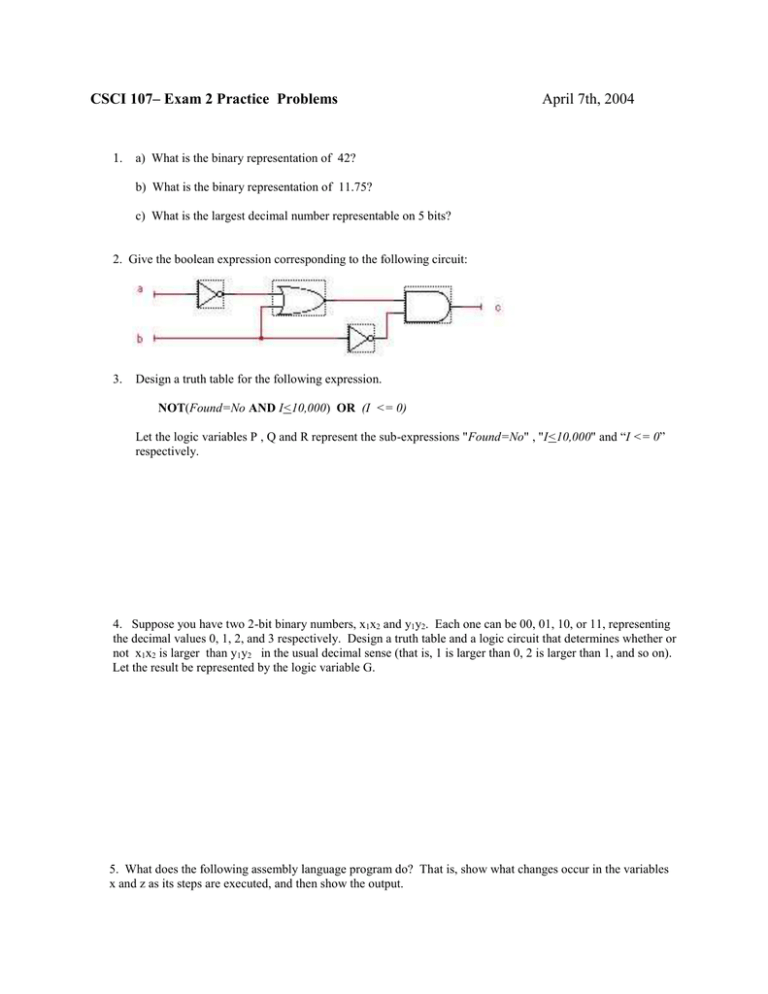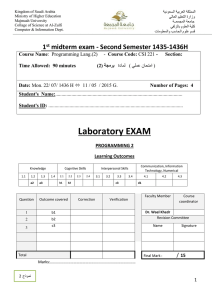CSCI 107– Exam 2 Practice Problems April 7th, 2004
advertisement

CSCI 107– Exam 2 Practice Problems
1.
April 7th, 2004
a) What is the binary representation of 42?
b) What is the binary representation of 11.75?
c) What is the largest decimal number representable on 5 bits?
2. Give the boolean expression corresponding to the following circuit:
3.
Design a truth table for the following expression.
NOT(Found=No AND I<10,000) OR (I <= 0)
Let the logic variables P , Q and R represent the sub-expressions "Found=No" , "I<10,000" and “I <= 0”
respectively.
4. Suppose you have two 2-bit binary numbers, x1x2 and y1y2. Each one can be 00, 01, 10, or 11, representing
the decimal values 0, 1, 2, and 3 respectively. Design a truth table and a logic circuit that determines whether or
not x1x2 is larger than y1y2 in the usual decimal sense (that is, 1 is larger than 0, 2 is larger than 1, and so on).
Let the result be represented by the logic variable G.
5. What does the following assembly language program do? That is, show what changes occur in the variables
x and z as its steps are executed, and then show the output.
.BEGIN
LOOP: LOAD x
ADD two
STORE x
COMPARE z
JUMPGT LOOP
OUT x
HALT
two:
.DATA 2
x:
.DATA 4
z:
.DATA 12
.END
6. Consider the program below which searches for a target value in a list of integers – it should be familiar to
you.
How would you change it to find and print all occurrences of the target value? Show the changes directly
on the code below.
// File: fig29.cpp This is a C++ version of the pseudocode
// program in Figure 2.9 in your text.
#include <iostream.h>
void getArray(int x[], int &m) {
int j;
cout << "Enter some integers (0 to finish): ";
cin >> j;
m=0;
while (j!=0) { x[m]=j; m=m+1; cin >> j; }
}
void main() {
int target, index, n, L[50];
int found;
getArray(L, n);
// declare variables
// initialize L and n
cout << "Enter a target value: "; // Step 1
cin >> target;
index = 0;
// Step 2
found = 0;
while (!found && index<n) {
// Step 3
// Step 4
if (L[index] == target) {
// Step 5
cout << " value found at index " << index;
found = 1;
}
else {
index = index + 1;
}
} //end while
if (!found)
cout << "value not found" << endl;
// Step 6
// step 7
// Step 8
// Step 9
// Step 10
}
7.
Below is a C++ program that searches for the maximum value in an array of integers. It corresponds to the
pseudocode algorithm in Figure 2.10.
1) What output does this program give for an array L with the values 6, 3, 7, 2, 7, 4, 1, 0 (in that order)?
2) Show the values of all variables in this main program while it is running with this particular array.
// File: fig210.cpp This is a C++ version of the pseudocode
// program in Figure 2.10 in your text.
#include <iostream.h>
void getArray(int x[], int &m) {
int j;
cout << "Enter some integers (0 to finish):";
cin >> j;
m=0;
while (j!=0) { x[m]=j; m=m+1; cin >> j; }
}
void main() {
int maximum, location, n;
// declare variables
int index, L[50];
getArray(L, n);
// initialize L and n
maximum = L[0];
// Step 1
location = 0;
// Step 2
index = 0;
// Step 3
while (index < n) {
// Step 4
if (L[index] > maximum)
// Step 5
{ maximum = L[index];
// Step 6
location = index;
// step 7
}
index = index + 1;
// Step 8
}
cout << "Maximum = " << maximum << endl;
cout << "its location = " << location << endl;
}
8. Consider the program below for aadding two 4-digit numbers —it should be familiar to you.
How would you change it to compute the sum of two 15-digit decimal numbers?
Show the changes in the code itself.
// File: fig12.cpp This is a C++ version of the pseudocode
// program in Figure 1.2 in your text.
#include <iostream.h>
void getArray(int x[], int n) {
int i, j;
cout << "Enter " << n << " integers:";
i=0;
while (i<n) { cin >> j; x[i]=j; i=i+1; }
}
void printArray(int x[], int n) {
int i;
i = 0;
while (i<n) { cout << x[i]; i=i+1; }
cout << endl;
}
void main() {
int i, carry, m;
int a[4], b[4], c[5];
m = 4;
// declare variables
getArray(a, m);
getArray(b, m);
carry = 0;
i = 0;
while (i<m) {
// Step 1
// Step 2
// Step 3
c[i] = a[i] + b[i] + carry;
if (c[i] >= 10) {
c[i] = c[i] - 10;
carry = 1;
}
else carry = 0;
i = i + 1;
}
c[m] = carry;
printArray(c, m);
}
// Step 4
// Step 5
// Step 6
// Step 7
// Step 8
// Step 9
9. Write a C++ program that takes a series of n numbers from the user and displays the sum of all the negative
numbers in that series (the program should stop when the user enters 0).
10. Write a C++ program that reads from the user two arrays of 10 numbers, one array at a time, and decides
whether the two arrays are identical (i.e., contain the same numbers in the same order).
What would it change if you had to decide whether the two arrays contain the same numbers, but not necessarily
in the same order? For instance, the arrays {1, 3, 2, 4} and {2, 3, 4, 1} would be the same. Just describe your
solution in words, you do not need to write code.





